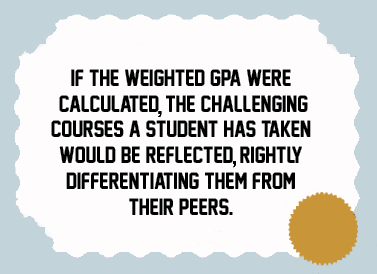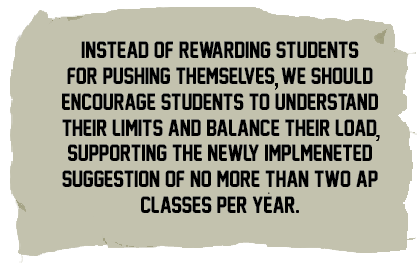Your donation will support the student journalists of Palo Alto High School's newspaper
The weighted GPA debate
October 30, 2015
The Breakdown
Palo Alto High School and Henry M. Gunn High School appear to be on the eve of a conclusion to the long evolution of the use of weighted grades on high school transcripts.
Grades have been unweighted at Paly since at least 1999-2000, with on lythe unweighted grade point average (GPA) appearing on transcripts. The only changes in that time period were made to the ranking system for GPAs.
Currently, Gunn’s school profile only provides a GPA context chart for unweighted grades. This change came in early October after over 10 yeras of both weighted and unweighted grades appearing on the profile.
However, Gunn will continue to give students the option to list both unweighted and weighted GPAs on their transcripts for the Class of 2016.
Future classes’ fates will be determined in the upcoming months at a school board meeting, according to Palo Alto Unified School District Superintendent Max McGee. McGee has made aligning the two high schools’ reporting systems a top priority.
“We are a school district with a central vision and core beliefs,” McGee said. “The inconsistencies are a source of stress.”
The district is currently looking for student feedback as to whether Gunn should make the transition away from listing weighted grades on transcripts.
“I am really interested in what students have to say,” McGee said. “I have already heard from many students on both sides of the debate.”
With this in mind, The Campanile takes a closer look at both sides of the argument that has divided the Palo Alto community, through the following student opinions.
Con
Though fads like “test optional” and “no writing supplement” come and go, the GPA has and will remain an integral part of the college application. Whether you received an A in Chemistry Honors or failed Advanced Placement U.S. History (APUSH), your grades are boiled down to four digits, a universal formula for colleges across the country to compare students near and far. As the college admissions process becomes evermore competitive, applicants are constantly looking for ways to rise above the competition. Some suggest imposing weighted GPAs on transcripts, in which a student receives an extra point on their GPA for any honors or AP course. Some believe that rewarding rigor is the way to go. Think again.
The extreme intensity of many college applicants is undeniable; some students are on the brink of insanity. Earning an extra point on the GPA scale drives some students to increase the number of rigorous courses. This practice is horrible for student health, a topic which the community of Palo Alto already struggles with. Instead of rewarding students for pushing themselves, we should encourage students to understand their limits and balance their load, supporting the newly implemented suggestion of no more than two AP classes per year. Supporting unweighted grades supports the student who takes a mix of rigorous and manageable classes. Supporting weighted grades, however, supports students who overload their class schedule, with the safety net that they do not have to earn as high of a grade. We need to remind students to stay in tune with their own mental health needs.
All of the GPA stress builds up to the pinnacle of college. High school is designed to prepare graduates for college work. If we are rewarding rigorous courses with an extra GPA point, we are then creating a false incentive. It represents a carrot in front of students, leading them to success.
Motivation should come from an intrinsic desire to learn a specific subject, not from a potential boost in college admissions. Regardless, this incentive will disappear once Paly graduates arrive on college campus. There is no “bonus” for taking particular classes. If students learn to balance their course load and pick classes for genuine interest, they will be adequately prepared to select courses in college. Prioritizing unweighted GPAs teaches students that valuable lesson of self-motivation, which is necessary to be successful at college and beyond.
Others fear that an unweighted GPA will result in students not challenging themselves. For instance, taking fewer AP’s because th ey do not receive GPA weight will make students less smart or prepared for the future. However, any minor change in APs will have little effect, overall, considering that Paly already excels in APs. According to Paly’s school profile, 50 percent of Paly AP tests earn a five, the highest possible score. This can be compared to just 13.3 percent of tests nationwide that earn a five, according to the College Board, the organization that proctors the AP tests. The GPA is one of the few metrics in college admissions that is relatively unsusceptible to variation. Instead, the GPA intends to offer a numerical value for grades so that admissions officers can compare the high school academic success of applicants. Granted, there is some degree of variability. For example, grade inflation or deflation can be a factor at certain schools.
ey do not receive GPA weight will make students less smart or prepared for the future. However, any minor change in APs will have little effect, overall, considering that Paly already excels in APs. According to Paly’s school profile, 50 percent of Paly AP tests earn a five, the highest possible score. This can be compared to just 13.3 percent of tests nationwide that earn a five, according to the College Board, the organization that proctors the AP tests. The GPA is one of the few metrics in college admissions that is relatively unsusceptible to variation. Instead, the GPA intends to offer a numerical value for grades so that admissions officers can compare the high school academic success of applicants. Granted, there is some degree of variability. For example, grade inflation or deflation can be a factor at certain schools.
However, this variability is only multiplied by comparing weighted GPAs. Part of this is due to Paly’s own inconsistent weighting. For example, in the 2012-2013 school year, Chemistry Honors was deemed a weighted course by the UC/CSU system. However, in the following school year of 2013-2014, Chemistry Honors was no longer given weight. A note included in the Paly course catalog states “9th and 10th grade courses are not eligible to receive weighted credit from [California State Universities/Universities of California (CSU/UC)]; therefore, this course will not count as a weighted course for UC and CSU purposes.” Thus, this inconsistency in grading would make it hard for any admissions officer to understand Paly’s GPA system year to year, given that it seems to be in constant flux. Since CSU/UC schools do not look at grades from senior year, weighted credit is limited to junior year. This further encourages students to load up on rigorous courses during junior year, a year in which students already face the burden of standardized testing and challenging academics. If CSU/UC weighting were to differ from Paly’s own weighting, this would further confuse both students and colleges regarding GPA. The entire premise of the GPA is to provide a standard metric for grades, yet if we continually alter our weighting system, achieving that standard metric is impossible.
Additionally, weighted GPAs prove impractical when comparing applicants of different schools. Each school offers a different number of AP and Honors courses. Some schools even have unique weighting systems, giving a half or full point for Honors courses or offering bonus points for those involved in athletics or clubs. Therefore, some students would be able to earn a higher weighted GPA than others, if their school offered more rigorous courses. It would be ineffective to compare students with numerical values that are not comparable. For that reason, many selective schools find that the GPA is a less valuable tool for them when evaluating academics.
Some high-achieving students fear that eliminating a weighted GPA option will mask the rigor in their courses. However, regardless of the GPA scale used by high schools, colleges view the rigor on student transcripts above all. Colleges can specifically see in which courses the student excels or struggles and the rigor of those specific courses. However, to get a quick and easy picture of a student’s academic abilities, unweighted GPA would serve a greater purpose because it provides a standard metric, that can then be verified and clarified through the full transcript.
“Academic performance is instead measured by grades in academic courses,” an admissions officer from Duke University wrote to The Campanile. “We look at the student’s transcript, course by course, grade by grade, to uncover the student’s four year journey through his/her academics.”
Ultimately, Paly should remain with its unweighted system, despite calls for a weighted GPA. Gunn should also make the move to unweighted GPAs, for the sake of consistency and the students.
Pro
Advanced Placement (AP) BC Calculus is the same as Intro to Algebra. AP U.S. History is the same as U.S. History. AP Physics C is the same as Physics. From the standpoint of an unweighted grade point average (GPA), these statements are true. The first thing that anyone looks at when trying to measure a student’s academic achievement is his or her GPA. In the case of Palo Alto High School, this means a student’s unweighted GPA. Though the unweighted GPA may seem like a fair, simple and clean way to quickly gauge the academic proficiency of a student, it is in fact an unfair, overly broad and inaccurate measurement, and should be coupled with a weighted GPA. High schools should calculate the weighted GPA, making it available on a student’s transcript and in the GPA context on the school’s profile, to provide colleges with a clearer idea of a student’s academic performance in high school. Seventy-two percent of high schools calculate weighted GPAs, according to the National Association for College Admission Counseling’s 2013 State of College Admission Report, and so should the Palo Alto Unified School District.
A common belief is that the greater the risk, the more rewarding the benefits should be. This expectation is no different with AP and honors classes. These classes are inherently more difficult than unweighted classes, and should be rewarded as such. Just looking at the unweighted GPA, a student with a 4.0 GPA taking all non-honors and non-AP classes looks the exact same as a student with a 4.0 GPA taking honors and AP classes. However, the latter student has clearly demonstrated much more academic rigor, something that is not reflected in the unweighted GPA. If the weighted GPA were calculated, the challenging courses a student has taken would be reflected, rightly differentiating them from their peers.
And just like any risk or challenge, taking harder courses means a higher chance of failing. The risk of earning a B or C in a weighted class is a major deterrent for many students considering taking AP or honors classes, because they fear that taking these classes will ruin their unweighted GPA. Schools should not discourage students from stretching themselves a little.
But in the case of th e weighted GPA, a lower grade in these higher level courses has less of an impact on the GPA to reflect the difficulty of the class. With the weighted GPA available, students would be more inclined to take the risk and challenge themselves in a course that they might be very interested in but are afraid of not doing so well in, because the weighted GPA would provide a cushion with that extra grade point. If there is any right time to take the risk of taking a hard class, high school is the time to do it while the extra grade point is still available, since college will not provide that cushion. But what does this high school calculated GPA matter for? Though it is true that some (but certainly not all) colleges recalculate a student’s GPA based on their own grading system when looking at applications, including University of California (UC) schools, a high school calculated GPA still has a huge impact on a student in the collegiate world. One major impact is on a student’s ranking. Though Paly does not rank its students, it does split up students into ranked quintiles in the GPA context chart available to colleges — and based on solely unweighted GPAs. These rankings are used for a variety of purposes, including merit scholarships for colleges and the admission process itself. At a school as competitive and high performing as Paly, a student taking many challenging courses with a few lower grades can end up in a lower category than a student with a very light course load and higher grades.
e weighted GPA, a lower grade in these higher level courses has less of an impact on the GPA to reflect the difficulty of the class. With the weighted GPA available, students would be more inclined to take the risk and challenge themselves in a course that they might be very interested in but are afraid of not doing so well in, because the weighted GPA would provide a cushion with that extra grade point. If there is any right time to take the risk of taking a hard class, high school is the time to do it while the extra grade point is still available, since college will not provide that cushion. But what does this high school calculated GPA matter for? Though it is true that some (but certainly not all) colleges recalculate a student’s GPA based on their own grading system when looking at applications, including University of California (UC) schools, a high school calculated GPA still has a huge impact on a student in the collegiate world. One major impact is on a student’s ranking. Though Paly does not rank its students, it does split up students into ranked quintiles in the GPA context chart available to colleges — and based on solely unweighted GPAs. These rankings are used for a variety of purposes, including merit scholarships for colleges and the admission process itself. At a school as competitive and high performing as Paly, a student taking many challenging courses with a few lower grades can end up in a lower category than a student with a very light course load and higher grades.
An example close to home is the Eligibility in the Local Context program, initiated by the UC system. In this program, California high schools submit the top 15 percent of each class to the program, which will then use its own system to calculate the top nine percent, who will be guaranteed a spot at one of the UC campuses. This initial top 15 percent is based solely on the unweighted GPA, potentially squeezing out students who chose to challenge themselves rather than take all easy courses.
Even once a student has been admitted to a college, his or her high school unweighted GPA can still be a burden — a burden worth up to thousands of dollars a year. In the case of the University of Colorado Boulder, scholarships are determined by looking at the “weighted ninth-12th grade GPA that is reflected on the transcript… [the university] will not recalculate GPAs, but take them directly off of the transcript,” according to the university’s website. This means a student with only an unweighted GPA will be compared directly with students with weighted GPAs, putting the unweighted student at a disadvantage for being awarded a scholarship.
A common protest against weighted GPAs stems from the enduring concern in the Palo Alto community that Palo Alto’s high schools have overly high levels of stress. Some point to the high number of AP classes that students feel they need to take in order to be “successful” and go to a good college. They believe a weighted GPA would only encourage stress because students would attempt to take one too many AP courses in order to boost their GPA, so weighted GPAs should not be an option in order to reduce stress. This belief that taking more challenging courses should be discouraged in order to reduce stress is absurd.
This year, Challenge Success, an organization based at Stanford University that partners with schools to improve learning environments, conducted a survey at Henry M. Gunn High School. Through 1,594 responses, researchers found that on average, students taking two or fewer AP or honors courses “reported significantly more academic worry” than students taking three or more AP or honors courses, according to the Stanford Survey of Adolescent School Experiences Report on Gunn. The correlation between more stress and more challenging courses is nonexistent, so it cannot be assumed that more stress would follow the calculation of a weighted GPA.
Every piece of a student’s transcript tells admission officers and others a little bit more about that student’s academic proficiency. All these elements, from courses to grades to GPA, are important, and adding one more piece to the puzzle by including the weighted GPA can only benefit a student. For these reasons, Paly should include the weighted GPA in addition to the unweighted GPA currently on a student’s transcript.
